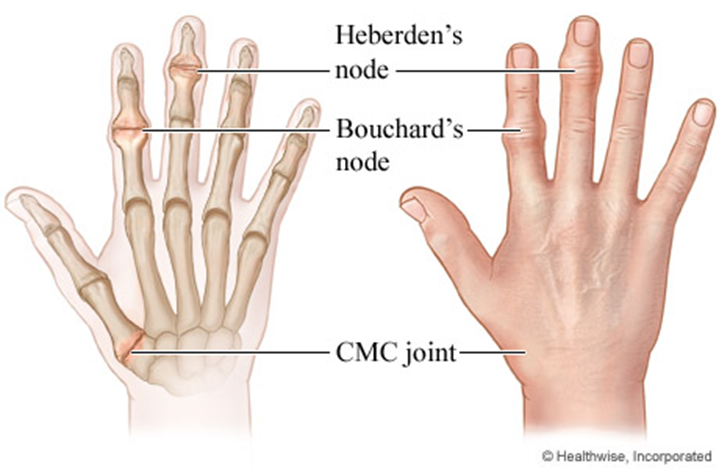While assessing a client with degenerative joint disease, the nurse observes Heberden's nodes, large prominences on the client's fingers that are reddened. The client reports that the nodes are painful. Which action should the nurse take?
Discuss approaches to chronic pain control with the client.
Review the client's dietary intake of high-protein foods.
Notify the healthcare provider of the finding immediately.
Assess the client's radial pulses and capillary refill time.
The Correct Answer is A
A. Discuss approaches to chronic pain control with the client:
This is the correct answer. Heberden's nodes are bony enlargements that can occur in osteoarthritis, particularly in the joints of the fingers. These nodes can be associated with pain. Discussing approaches to chronic pain control with the client is an appropriate nursing intervention to address the client's pain and improve quality of life.
B. Review the client's dietary intake of high-protein foods:
Dietary intake of high-protein foods is not directly related to the management of Heberden's nodes in degenerative joint disease. Pain control and joint protection measures are more relevant.
C. Notify the healthcare provider of the finding immediately:
While it's important to communicate significant findings to the healthcare provider, the presence of Heberden's nodes in degenerative joint disease may not require immediate notification unless there are other concerning symptoms or complications.
D. Assess the client's radial pulses and capillary refill time:
Assessing radial pulses and capillary refill time is not directly related to managing Heberden's nodes in degenerative joint disease. These nodes are primarily a result of joint changes in osteoarthritis.

Nursing Test Bank
Naxlex Comprehensive Predictor Exams
Related Questions
Correct Answer is D
Explanation
A. Have the client sign the surgical and transfusion permits:
While obtaining signed consent is important, the immediate concern is addressing the client's medication history, especially the use of heparin, which can contribute to bleeding.
B. Ensure that the potential for bleeding is explained to the client:
Education about the potential for bleeding is important, but the immediate action is to communicate the client's medication history to the healthcare provider for appropriate guidance.
C. Observe the heparin injection sites for signs of bruising:
Monitoring for bruising at injection sites is a consideration, but it is not the priority when the client is actively bleeding from an open fracture.
D. Notify the healthcare provider of the client's medication history:
This is the correct answer. Heparin is an anticoagulant, and its use can increase the risk of bleeding during surgery. The healthcare provider needs to be informed of the client's current medication history to make decisions regarding the timing and management of heparin therapy in the perioperative period.
Correct Answer is D
Explanation
A. Reduced pain in eczematous areas:
While hydration of the skin may contribute to reduced pain in some cases, the primary goal of urea cream is to moisturize and hydrate the skin rather than directly address pain.
B. Healing with a return to normal skin appearance:
Urea cream can contribute to the healing process by hydrating the skin and promoting the removal of dry, scaly skin. However, complete healing and a return to normal skin appearance may also depend on the underlying cause of eczema and other factors.
C. Decreased weeping of ulcerations in affected areas:
Urea cream can help reduce excessive dryness and weeping in eczematous areas by promoting hydration and moisture balance. However, it may not directly address ulcerations, and other interventions may be needed for open wounds.
D. Hydration of affected dry skin areas:
This is the correct answer. Urea is a natural moisturizing factor that helps retain water in the skin. Applying urea cream to affected dry skin areas is expected to hydrate the skin, reduce dryness, and improve the overall moisture balance.
Whether you are a student looking to ace your exams or a practicing nurse seeking to enhance your expertise , our nursing education contents will empower you with the confidence and competence to make a difference in the lives of patients and become a respected leader in the healthcare field.
Visit Naxlex, invest in your future and unlock endless possibilities with our unparalleled nursing education contents today
Report Wrong Answer on the Current Question
Do you disagree with the answer? If yes, what is your expected answer? Explain.
Kindly be descriptive with the issue you are facing.
